load capacity TOYOTA TACOMA 2018 Owners Manual (in English)
[x] Cancel search | Manufacturer: TOYOTA, Model Year: 2018, Model line: TACOMA, Model: TOYOTA TACOMA 2018Pages: 696, PDF Size: 11.72 MB
Page 170 of 696
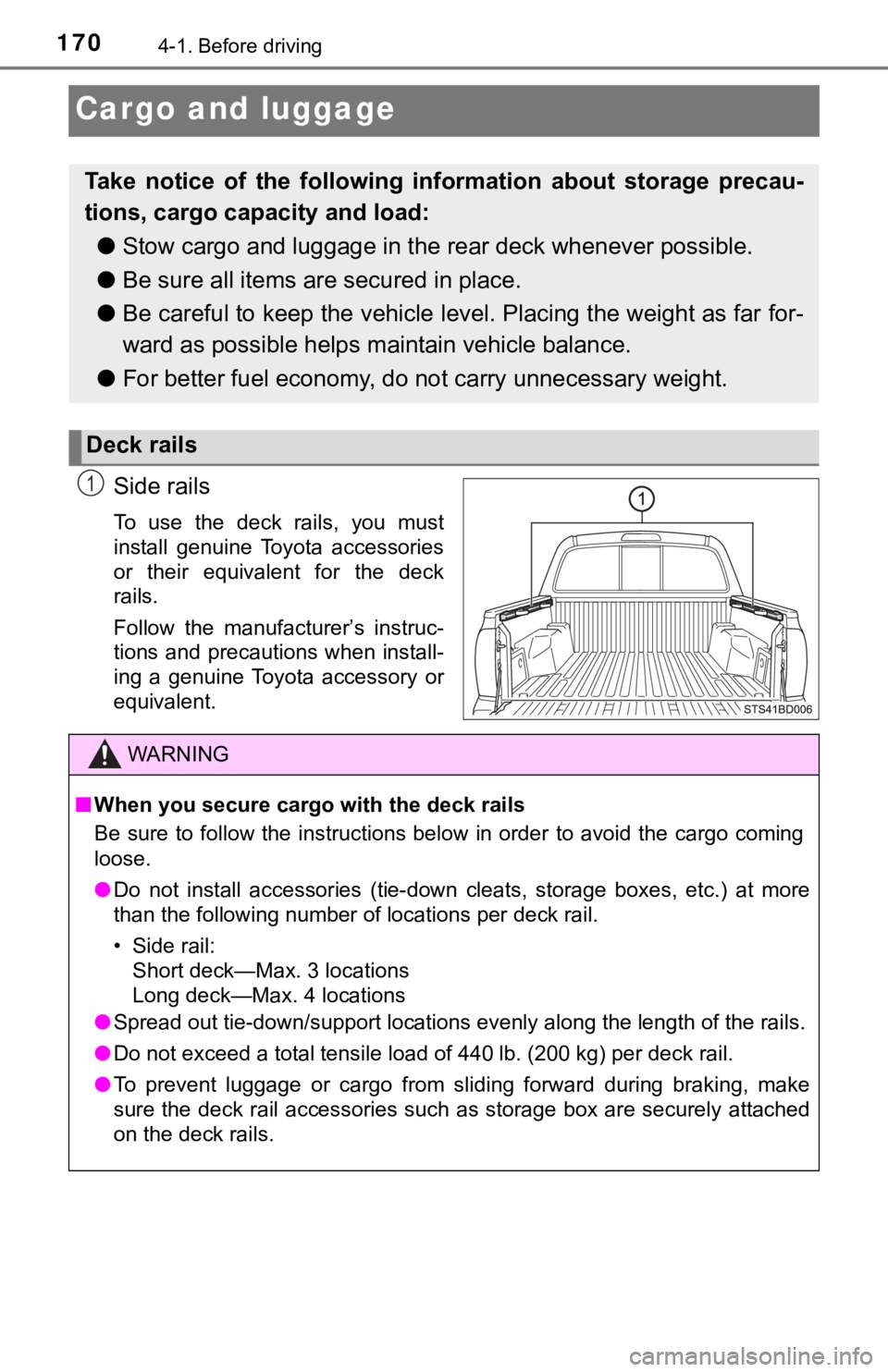
1704-1. Before driving
Cargo and luggage
Side rails
To use the deck rails, you must
install genuine Toyota accessories
or their equivalent for the deck
rails.
Follow the manufacturer’s instruc-
tions and precautions when install-
ing a genuine Toyota accessory or
equivalent.
Take notice of the following information about storage precau-
tions, cargo capacity and load:‚óŹ Stow cargo and luggage in the rear deck whenever possible.
‚óŹ Be sure all items are secured in place.
‚óŹ Be careful to keep the vehicle level. Placing the weight as far for-
ward as possible helps m aintain vehicle balance.
‚óŹ For better fuel economy, do no t carry unnecessary weight.
Deck rails
1
WARNING
‚Ė†When you secure cargo with the deck rails
Be sure to follow the instructions below in order to avoid the cargo coming
loose.
‚óŹ Do not install accessories (tie-down cleats, storage boxes, etc .) at more
than the following number of locations per deck rail.
‚ÄĘ Side rail: Short deck‚ÄĒMax. 3 locations
Long deck‚ÄĒMax. 4 locations
‚óŹ Spread out tie-down/support locations evenly along the length o f the rails.
‚óŹ Do not exceed a total tensile load of 440 lb. (200 kg) per deck rail.
‚óŹ To prevent luggage or cargo from sliding forward during braking , make
sure the deck rail accessories such as storage box are securely attached
on the deck rails.
Page 171 of 696

1714-1. Before driving
4
Driving
Cargo capacity depends on the total weight of the occupants.
(Cargo capacity) = (Total load capacity)  (Total weight of occupants)
Steps for Determining Correct Load Limit ‚ÄĒ
(1) Locate the statement “The co mbined weight of occupants and
cargo should never exceed XXX kg or XXX lbs.‚ÄĚ on your vehicle‚Äôs
placard.
(2) Determine the combined weight of the driver and passengers t hat
will be riding in your vehicle.
(3) Subtract the combined weight of the driver and passengers fr om
XXX kg or XXX lbs.
(4) The resulting figure equals the available amount of cargo an d lug-
gage load capacity.
For example, if the ‚ÄúXXX‚ÄĚ amount equals 1400 lbs. and there wil l be
five 150 lb passengers in your vehicle, the amount of available
cargo and luggage load capacity is 650 lbs. (1400 ÔÄ≠ 750 (5ÔĆÔāīÔĆ150) =
650 lbs.)
(5) Determine the combined weight of luggage and cargo being loa ded
on the vehicle. That weight may n ot safely exceed the available
cargo and luggage load capac ity calculated in Step 4.
(6) If your vehicle will be towing a trailer, load from your tra iler will be
transferred to your vehicle. Consult this manual to determine h ow
this reduces the available cargo and luggage load capacity of y our
vehicle. ( ÔāģP. 174)
Capacity and distribution
Page 172 of 696
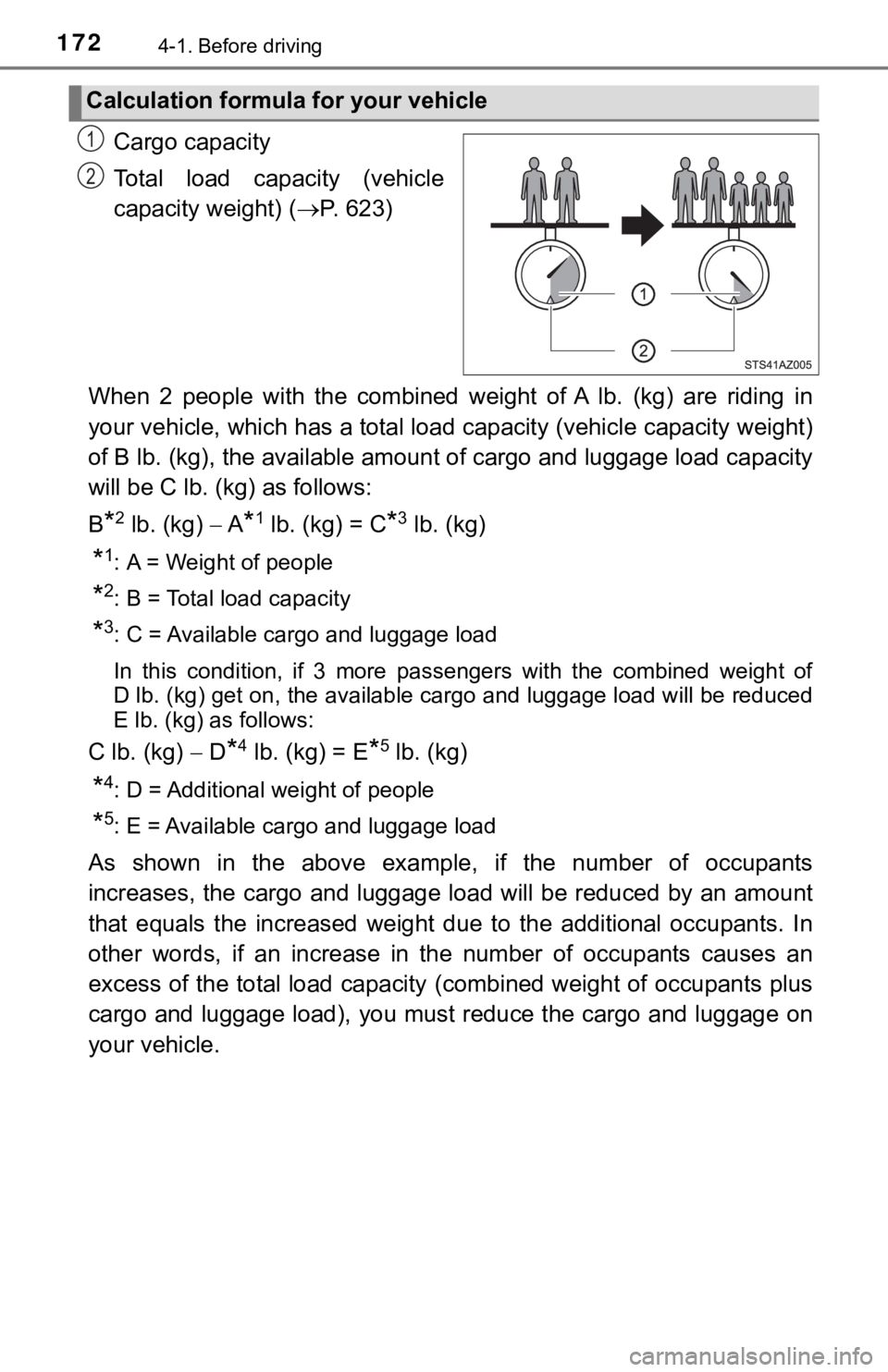
1724-1. Before driving
Cargo capacity
Total load capacity (vehicle
capacity weight) (ÔāģP. 623)
When 2 people with the combined weight of A lb. (kg) are riding in
your vehicle, which has a total load capacity (vehicle capacity weight)
of B lb. (kg), the available amount of cargo and luggage load c apacity
will be C lb. (kg) as follows:
B
*2 lb. (kg)  A*1 lb. (kg) = C*3 lb. (kg)
*1: A = Weight of people
*2: B = Total load capacity
*3: C = Available cargo and luggage load
In this condition, if 3 more passengers with the combined weigh t of
D lb. (kg) get on, the availabl e cargo and luggage load will be reduced
E lb. (kg) as follows:
C lb. (kg)  D*4 lb. (kg) = E*5 lb. (kg)
*4: D = Additional weight of people
*5: E = Available cargo and luggage load
As shown in the above example, if the number of occupants
increases, the cargo and luggage load will be reduced by an amo unt
that equals the increased weight due to the additional occupant s. In
other words, if an increase in the number of occupants causes a n
excess of the total load capacity (combined weight of occupants plus
cargo and luggage load), you must reduce the cargo and luggage on
your vehicle.
Calculation formul a for your vehicle
1
2
Page 173 of 696

1734-1. Before driving
4
Driving
WARNING
‚Ė†Things that must not be carried in the luggage compartment
The following things may cause a fire if loaded in the luggage compart-
ment:
‚óŹReceptacles containing gasoline
‚óŹAerosol cans
‚Ė†Storage precautions
Observe the following precautions.
Failure to do so may prevent the pedals from being depressed pr operly,
may block the driver’s vision, or may result in items hitting t he driver or
passengers, possibly causing an accident.
‚óŹDo not stack anything behind the front seats higher than the se at-
backs.
‚óŹDo not place cargo or luggage in or on the following locations.
‚ÄĘ At the feet of the driver
‚ÄĘ On the front passenger or rea r seats (when stacking items)
‚ÄĘ On the instrument panel
‚ÄĘ On the dashboard
‚ÄĘ On the auxiliary box or tray that has no lid
‚óŹSecure all items in the occupant compartment.
‚óŹNever allow anyone to ride in the rear deck. It is not designed for pas-
sengers. They should ride in thei r seats with their seat belts properly
fastened.
‚Ė†Capacity and distribution
‚óŹDo not exceed the maximum axle weight rating or the total vehic le
weight rating.
‚óŹEven if the total load of occupant‚Äôs weight and the cargo load is less
than the total load capacity, d o not apply the load unevenly. I mproper
loading may cause deterioration of steering or braking control which
may cause death or serious injury.
Page 174 of 696
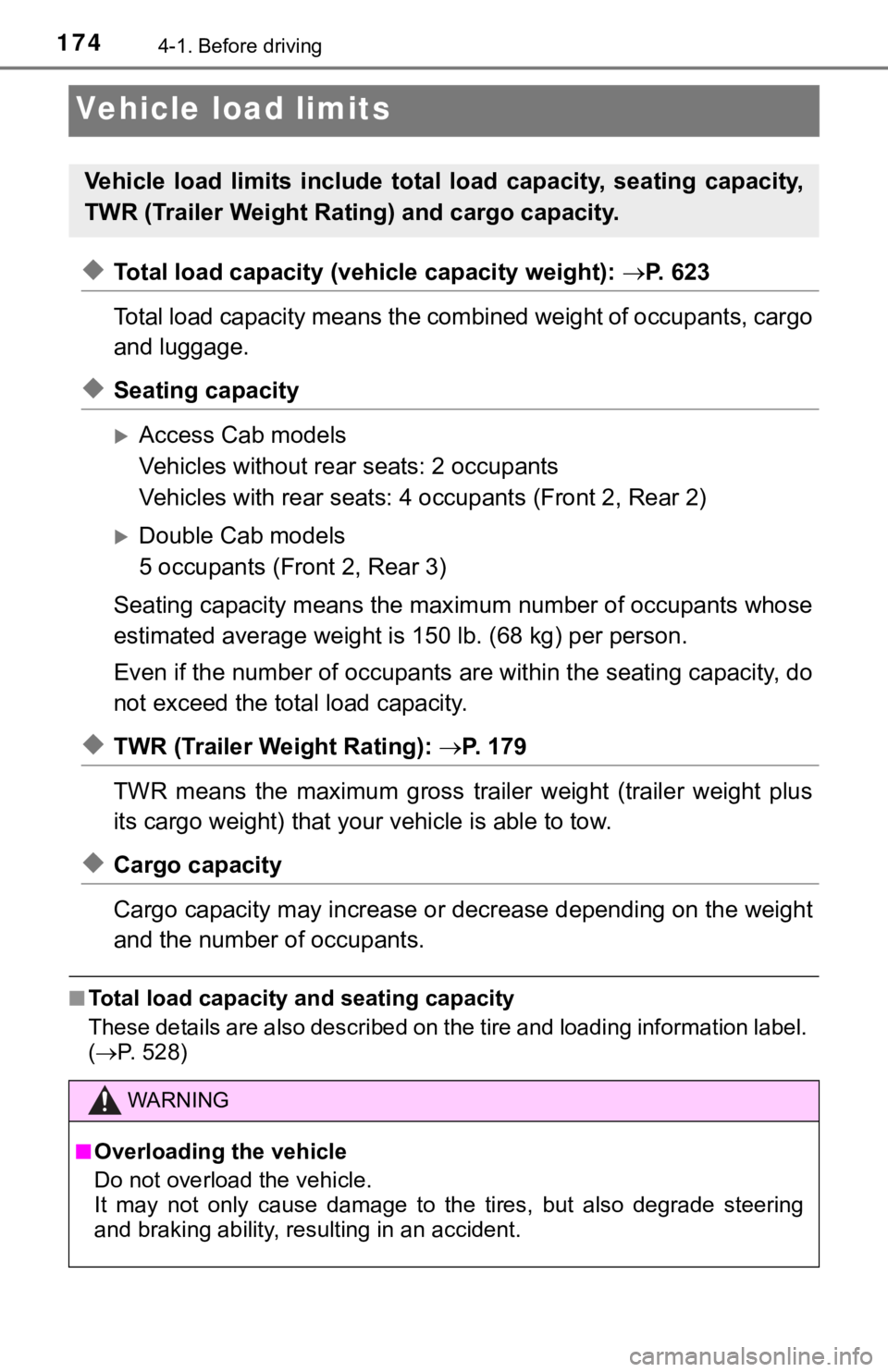
1744-1. Before driving
Vehicle load limits
‚óÜTotal load capacity (vehicle capacity weight): ÔāģP. 623
Total load capacity means the co mbined weight of occupants, cargo
and luggage.
‚óÜSeating capacity
ÔĀĶAccess Cab models
Vehicles without rear seats: 2 occupants
Vehicles with rear seats: 4 occupants (Front 2, Rear 2)
ÔĀĶDouble Cab models
5 occupants (Front 2, Rear 3)
Seating capacity means the max imum number of occupants whose
estimated average weight is 150 lb. (68 kg) per person.
Even if the number of occupants are within the seating capacity , do
not exceed the tota l load capacity.
‚óÜTWR (Trailer Weight Rating): ÔāģP. 179
TWR means the maximum gross trai ler weight (trailer weight plus
its cargo weight) that your vehicle is able to tow.
‚óÜCargo capacity
Cargo capacity may increase or decrease depending on the weight
and the number o f occupants.
‚Ė†Total load capacity and seating capacity
These details are also described on the tire and loading inform ation label.
( Ôāģ P. 528)
Vehicle load limits include total load capacity, seating capaci ty,
TWR (Trailer Weight Rati ng) and cargo capacity.
WARNING
‚Ė†Overloading the vehicle
Do not overload the vehicle.
It may not only cause damage to the tires, but also degrade steering
and braking ability, res ulting in an accident.
Page 190 of 696

1904-1. Before driving
WARNING
‚Ė†Trailer towing precautions
To tow a trailer safely, use extreme care and drive the vehicle in accordance
with the trailer’s characteristics and operating conditions. Failure to do so
could cause an accident resulting in death or serious injury. V ehicle stability
and braking performance are affected by trailer stability, brak e setting and
performance, and the hitch. Your vehicle will handle differentl y when towing
a trailer.
‚Ė† To avoid accident or injury
‚óŹ Do not exceed the TWR, unbraked TWR, GCWR, GVWR or GAWR.
‚óŹ If the gross trailer weight is over 2000 lb. (907 kg), a sway control device
with sufficient capacity is required.
‚óŹ If the gross trailer weight is over 5000 lb. (2268 kg), a weigh t distributing
hitch with sufficient capacity is required.
‚óŹ Adjust the tongue weight within the appropriate range. Place he avier loads
as close to the trailer axle as possible.
‚óŹ Do not exceed 65 mph (104 km/h), the posted towing speed limit or the
speed limit for your trailer as set forth in your trailer owner ’s manual,
whichever is lowest. Slow down sufficiently before making a turn, in cross-
winds, on wet or slippery surface, etc., to help avoid an accid ent. If you
experience a vehicle-trailer instability from reducing a certain speed, slow
down and make sure you keep your vehicle speed under the speed of
which you experience the instability.
‚óŹ Do not make jerky, abrupt or sharp turns.
‚óŹ Do not apply the brakes suddenly as you may skid, resulting in jackknifing
and loss of vehicle control. This is especially true on wet or slippery sur-
faces.
‚óŹ Do not exceed the trailer hitch assembly weight, gross vehicle weight,
gross axle weight and trailer tongue weight capacities.
‚óŹ Do not use cruise control (if equipped) or dynamic radar cruise control (if
equipped) when towing.
‚óŹ Slow down and downshift before descending steep or long downhil l
grades. Do not make sudden downshifts while descending steep or long
downhill grades.
‚óŹ Vehicle-trailer instability is more likely on steep long downhi lls. Before
descending steep or long downhill grades, slow down and downshi ft. Do
not make sudden downshifts when descending steep or long downhi ll
grades. Avoid holding the brake pedal down too long or applying the
brakes too frequently. This could cause the brakes to overheat and result
in reduced braking efficiency.
‚óŹ Do not tow a trailer when the temporary spare tire is installed on your vehi-
cle.
Page 324 of 696

3244-5. Using the driving support systems
WARNING
‚Ė†When the TRAC/VSC/Trailer Sway Control systems are turned off
Be especially careful and drive at a speed appropriate to the r oad condi-
tions. As these are the systems to help ensure vehicle stabilit y and driving
force, do not turn the TRAC/VSC/Trailer Sway Control systems of f unless
necessary.
‚Ė† Replacing tires
Make sure that all tires are of the specified size, brand, trea d pattern and
total load capacity. In addition, make sure that the tires are inflated to the
recommended tire inflation pressure level.
The ABS, Multi Terrain ABS, TRAC, VSC and Trailer Sway Control systems
will not function correctly if different tires are installed on the vehicle.
Contact your Toyota dealer for further information when replaci ng tires or
wheels.
‚Ė† Handling of tires and the suspension
Using tires with any kind of problem or modifying the suspensio n will affect
the driving assist systems, and may cause a system to malfuncti on.
‚Ė† Trailer Sway Control precaution
The Trailer Sway Control system is not able to reduce trailer sway in all situ-
ations. Depending on many factors such as the conditions of the vehicle,
trailer, road surface, and driving environment, the Trailer Swa y Control sys-
tem may not be effective. Refer to your trailer owner’s manual for informa-
tion on how to tow your trailer properly.
‚Ė† If trailer sway occurs
Observe the following precautions.
Failure to do so may c ause death or serious injury.
‚óŹ Firmly grip the steering wheel. Steer straight ahead.
Do not try to control trailer swaying by turning the steering w heel.
‚óŹ Begin releasing the accelerator pedal immediately but very grad ually to
reduce speed.
Do not increase speed. Do not apply vehicle brakes.
If you make no extreme correction with the steering or brakes, your vehicle
and trailer should stabilize. ( ÔāģP. 189)
Page 523 of 696
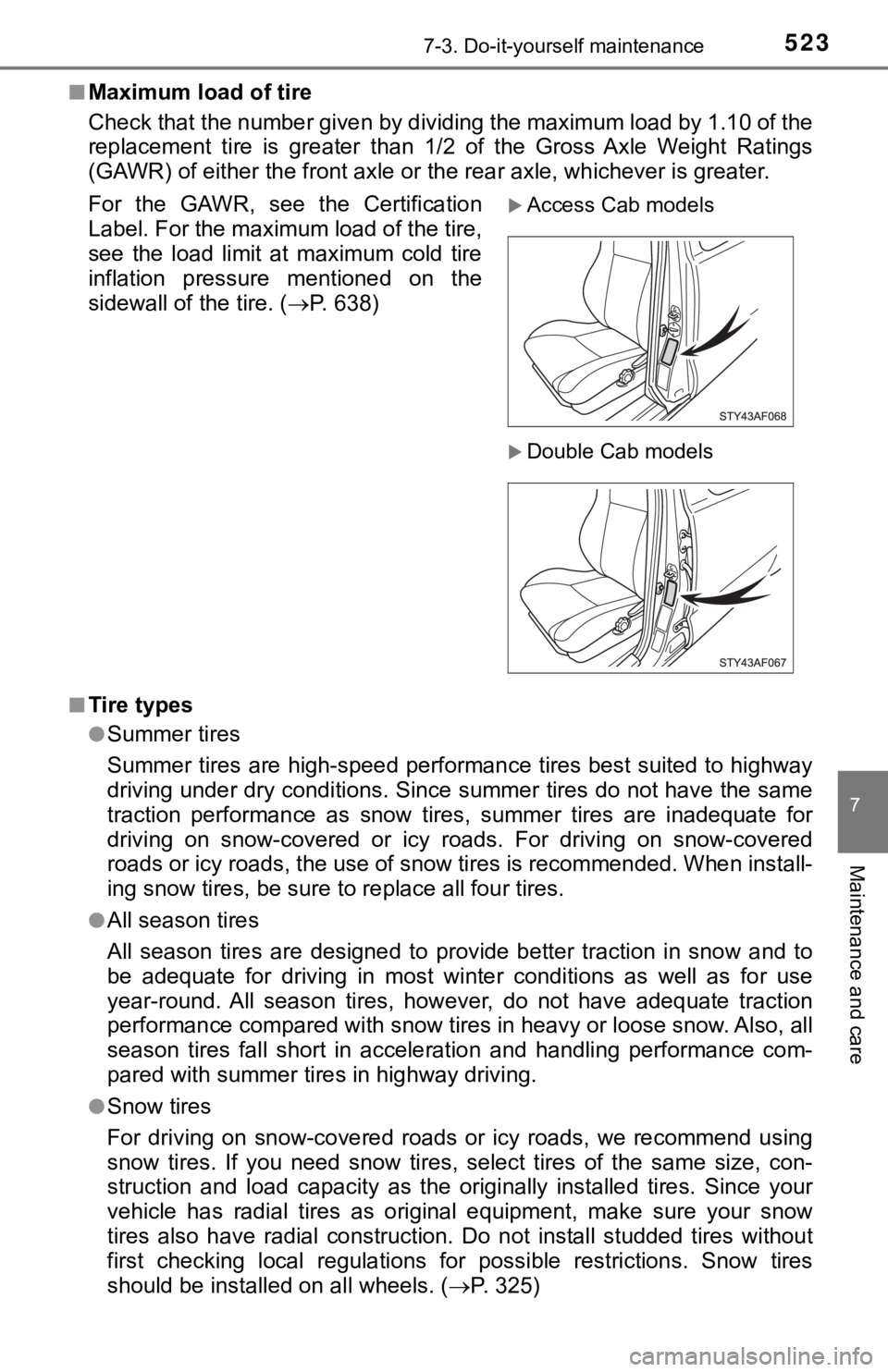
5237-3. Do-it-yourself maintenance
7
Maintenance and care
‚Ė†Maximum load of tire
Check that the number given by dividing the maximum load by 1.10 of the
replacement tire is greater than 1/2 of the Gross Axle Weight R atings
(GAWR) of either the front axle or the rear axle, whichever is greater.
‚Ė†Tire types
‚óŹSummer tires
Summer tires are high-speed performance tires best suited to hi ghway
driving under dry conditions. Si nce summer tires do not have th e same
traction performance as snow tires, summer tires are inadequate for
driving on snow-covered or icy ro ads. For driving on snow-covered
roads or icy roads, the use of snow tires is recommended. When install-
ing snow tires, be sure to replace all four tires.
‚óŹAll season tires
All season tires are designed to provide better traction in sno w and to
be adequate for driving in most winter conditions as well as fo r use
year-round. All season tires, however, do not have adequate tra ction
performance compared with snow tires in heavy or loose snow. Al so, all
season tires fall short in acceleration and handling performanc e com-
pared with summer tires in highway driving.
‚óŹSnow tires
For driving on snow-covered roads or icy roads, we recommend us ing
snow tires. If you need snow tires, select tires of the same si ze, con-
struction and load capacity as t he originally installed tires. Since your
vehicle has radial tires as original equipment, make sure your snow
tires also have radial construct ion. Do not install studded tires without
first checking local regulations for possible restrictions. Sno w tires
should be install ed on all wheels. (Ôāģ P. 325)
For the GAWR, see the Certification
Label. For the maximum load of the tire,
see the load limit at maximum cold tire
inflation pressure mentioned on the
sidewall of the tire. (
ÔāģP. 6 3 8 )
ÔĀĶAccess Cab models
ÔĀĶDouble Cab models
Page 531 of 696
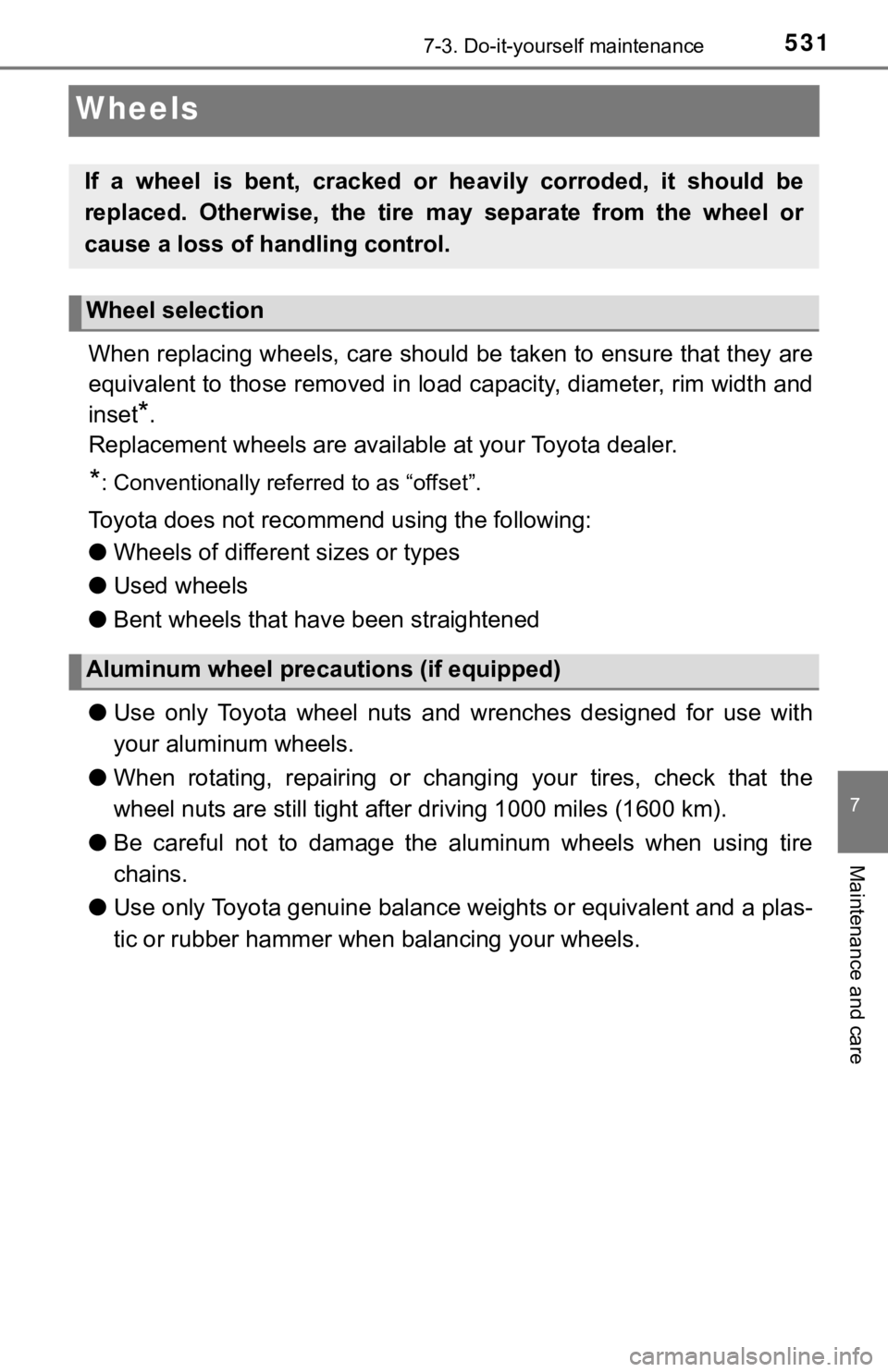
5317-3. Do-it-yourself maintenance
7
Maintenance and care
Wheels
When replacing wheels, care should be taken to ensure that they are
equivalent to those removed in load capacity, diameter, rim wid th and
inset
*.
Replacement wheels are available at your Toyota dealer.
*: Conventionally referred to as ‚Äúoffset‚ÄĚ.
Toyota does not recommend using the following:
‚óŹ Wheels of different sizes or types
‚óŹ Used wheels
‚óŹ Bent wheels that hav e been straightened
‚óŹ Use only Toyota wheel nuts and wrenches designed for use with
your aluminum wheels.
‚óŹ When rotating, repairing or changi ng your tires, check that the
wheel nuts are still tight afte r driving 1000 miles (1600 km).
‚óŹ Be careful not to damage the aluminum wheels when using tire
chains.
‚óŹ Use only Toyota genuine balance we ights or equivalent and a plas-
tic or rubber hammer when balancing your wheels.
If a wheel is bent, cracked or heavily corroded, it should be
replaced. Otherwise, the tire may separate from the wheel or
cause a loss of handling control.
Wheel selection
Aluminum wheel pre cautions (if equipped)
Page 644 of 696
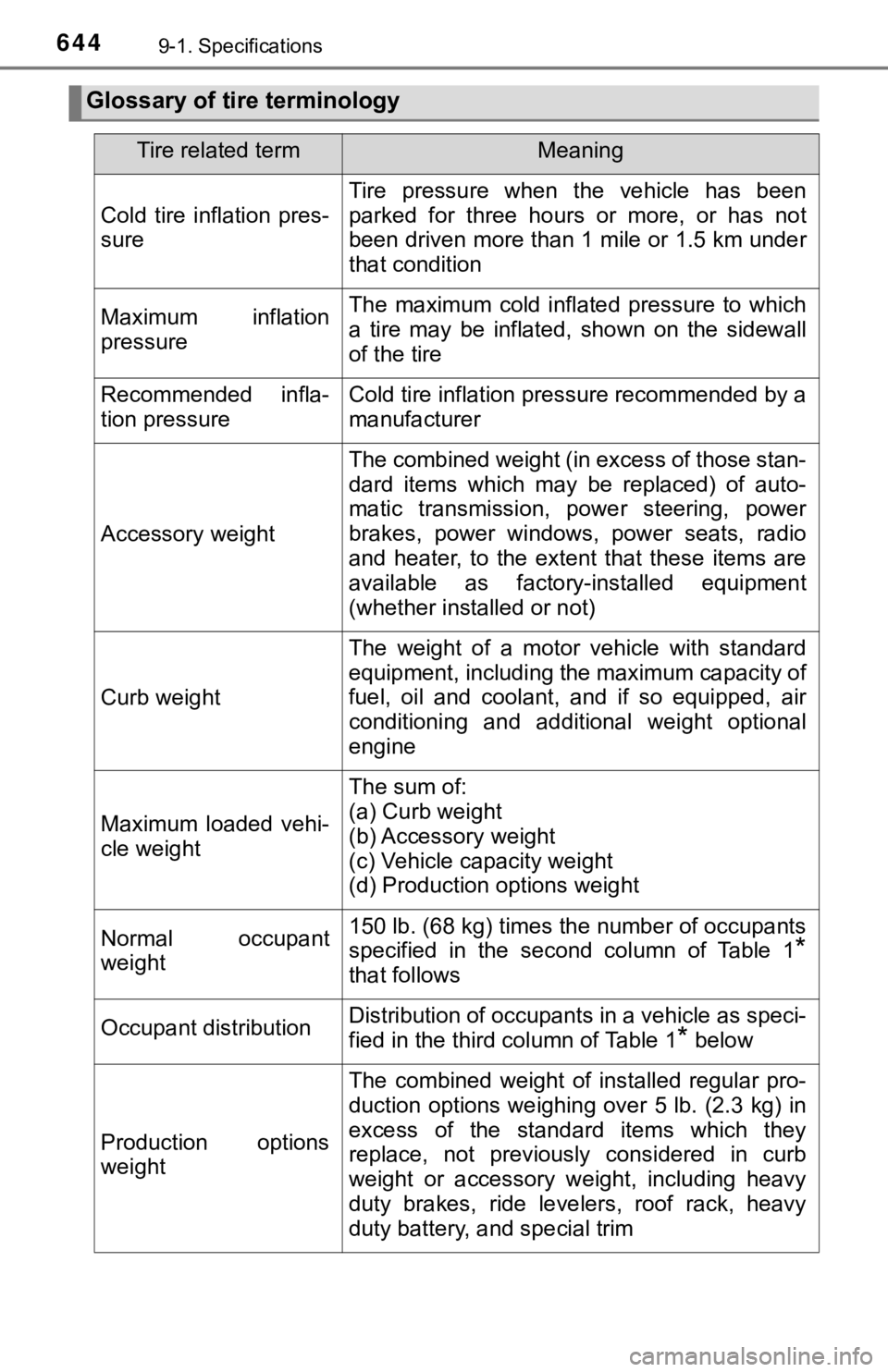
6449-1. Specifications
Glossary of tire terminology
Tire related termMeaning
Cold tire inflation pres-
sure
Tire pressure when the vehicle has been
parked for three hours or more, or has not
been driven more than 1 mile or 1.5 km under
that condition
Maximum inflation
pressureThe maximum cold inflated pressure to which
a tire may be inflated, shown on the sidewall
of the tire
Recommended infla-
tion pressureCold tire inflation pressure recommended by a
manufacturer
Accessory weight
The combined weight (in excess of those stan-
dard items which may be replaced) of auto-
matic transmission, power steering, power
brakes, power windows, power seats, radio
and heater, to the extent that these items are
available as factory-installed equipment
(whether installed or not)
Curb weight
The weight of a motor vehicle with standard
equipment, including the maximum capacity of
fuel, oil and coolant, and if so equipped, air
conditioning and additional weight optional
engine
Maximum loaded vehi-
cle weight
The sum of:
(a) Curb weight
(b) Accessory weight
(c) Vehicle capacity weight
(d) Production options weight
Normal occupant
weight150 lb. (68 kg) times the number of occupants
specified in the second column of Table 1
*
that follows
Occupant distributionDistribution of occupants in a vehicle as speci-
fied in the third column of Table 1
* below
Production options
weight
The combined weight of installed regular pro-
duction options weighing over 5 lb. (2.3 kg) in
excess of the standard items which they
replace, not previously considered in curb
weight or accessory weight, including heavy
duty brakes, ride levelers, roof rack, heavy
duty battery, and special trim